Disclaimer: This post may contain Amazon affiliate links. Sudachi earns a small percentage from qualifying purchases at no extra cost to you. See disclaimer for more info.
What is Sakura Mochi?
Sakura Mochi (桜餅) is a traditional pink dumpling made with sticky, glutinous rice filled with red bean paste and wrapped with a cherry blossom leaf. While the rice and filling are sweet, the surface takes on a subtle salty herbal flavor from the leaf giving Sakura Mochi a unique flavor like no other.
It gets its name from sakura (桜), the Japanese word for cherry blossom, and is most commonly associated with hanami (flower viewing) and spring when cherry blossoms are in bloom from late March to early April.
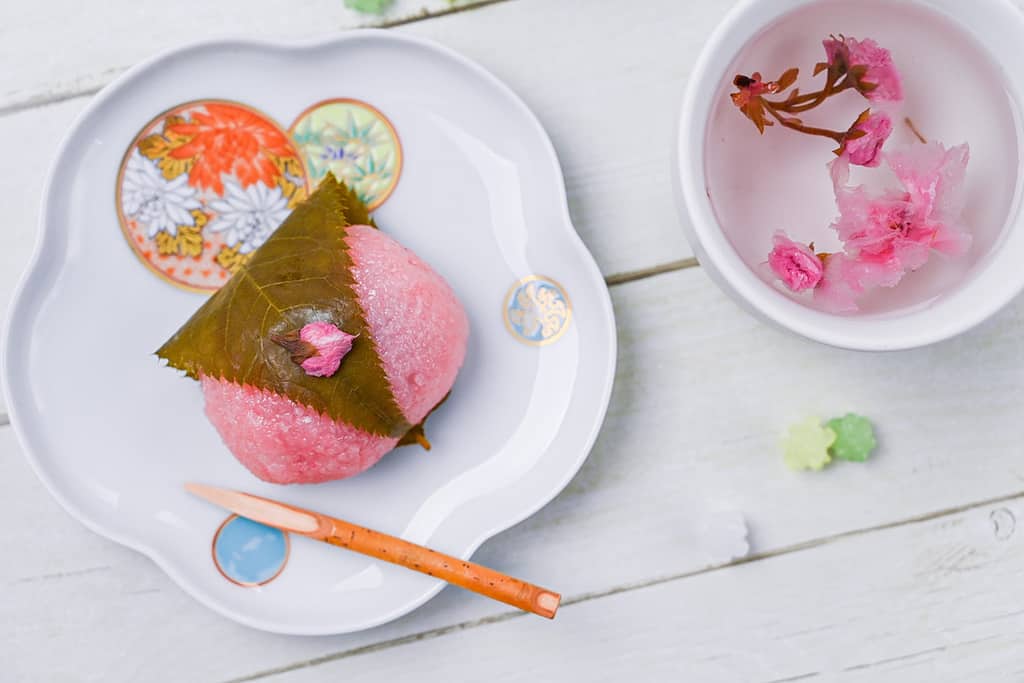
Regional Variations
There are two regional variations of Sakura Mochi and they are surprisingly quite different. Kansai style originates from the Western side of Japan (Osaka/Kyoto area) and Kanto style is from the east (around Tokyo).
Kansai style Sakura Mochi is traditionally made with a special type of sweet rice flour called “Domyojiko” and is sometimes known as “Domyoji Sakura Mochi”. Domyojiko is made by processing and crushing mochi rice into small granules, giving sakura an unusually wonderful texture somewhere between chewy mochi and sticky rice. It is believed to have originated and got its name from a temple called “Domyoji” in Osaka.

On the other hand, Kanto style is often compared to a crepe. Instead of a rice cake, the dough is made with a combination of regular flour and glutinous rice flour which is then fried like a pancake and wrapped around the red bean filling.
I live in central Japan where Kansai style is more popular, but both are delicious!
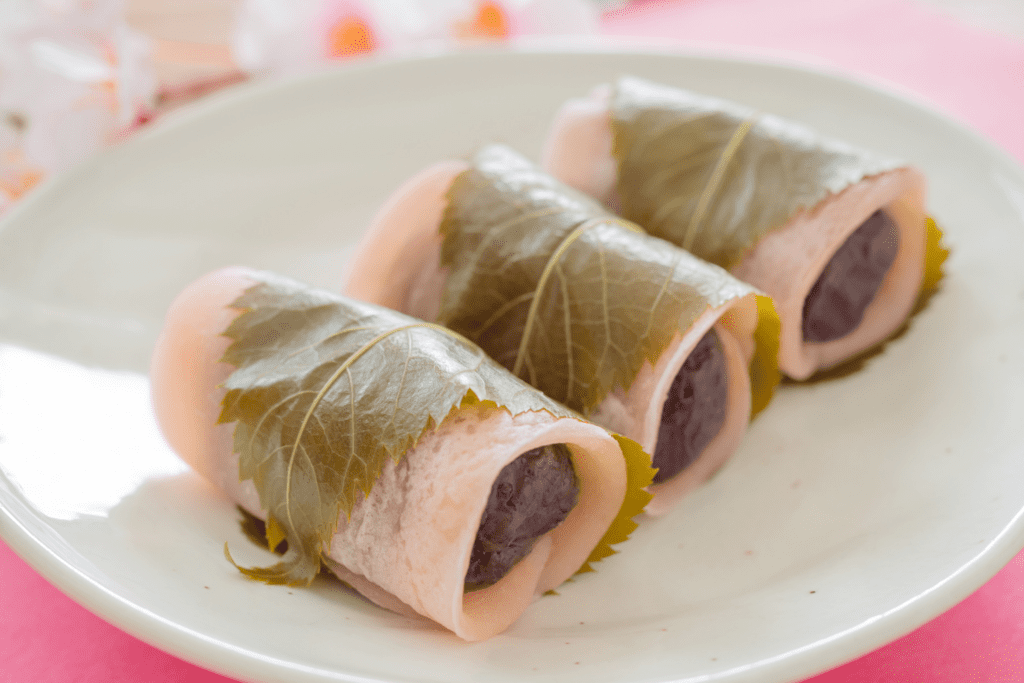
Ingredients
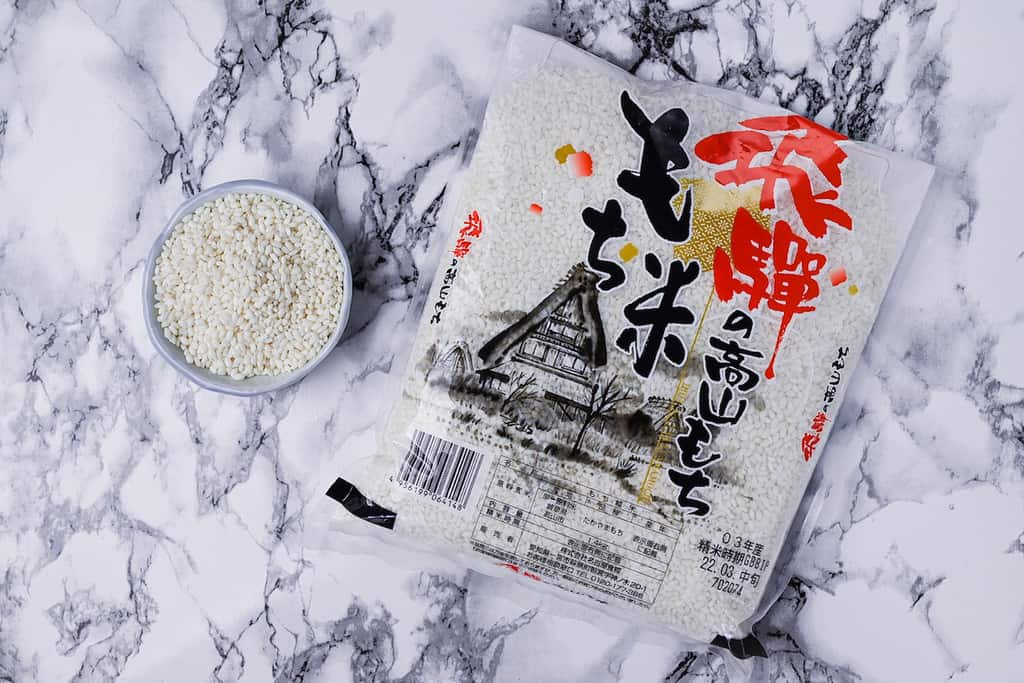
Sakura mochi requires a few special ingredients, for this recipe you will need:
- Glutinous Rice (Mochigome): Sakura Mochi is traditionally made with a type of rice “flour” called “Domyojiko” (道明寺粉). Domyojiko is a processed, granulated version of mochi rice and can be difficult to find, even in Japan. Instead, I will show you how to make sakura mochi using simple and accessible mochi rice (affiliate link), also sometimes called “sweet rice” in English. This recipe only works with mochi rice so unfortunately can’t be substituted.
- Salted Cherry Blossom Leaves: One of the most iconic parts of sakura mochi is “sakura no ha no shiozuke” (桜の葉の塩漬け) or “salt-pickled cherry blossom leaf”. You can buy them here on Amazon US (affiliate), or you can omit them. If you’re interested in trying to make them youself, see below for instructions!
- Salted Cherry Blossom Flowers (optional): Sakura no hana no shiozuke (桜の花の塩漬け) or “pickled cherry blossom flowers” are mainly for decoration. They need to be soaked to remove the excess salt before being placed on top of the Sakura Mochi. You can purchase them here on Amazon (affiliate) or simply omit them.
- White Sugar: To sweeten the rice, use white caster or granulated sugar.
- Pink Food Coloring: A few drops will give your Sakura Mochi that iconic shade of pink! If you prefer to use natural colorings, you could use a small amount of beet juice or raspberry juice (just be careful not to add too much to avoid altering the flavor).
- Smooth Red Bean Paste (Koshian): Sakura Mochi is always filled with red bean paste we call “anko”. The smooth type (koshian) is most common and you can buy it here on Amazon (affiliate link) or make your own using my recipe here.
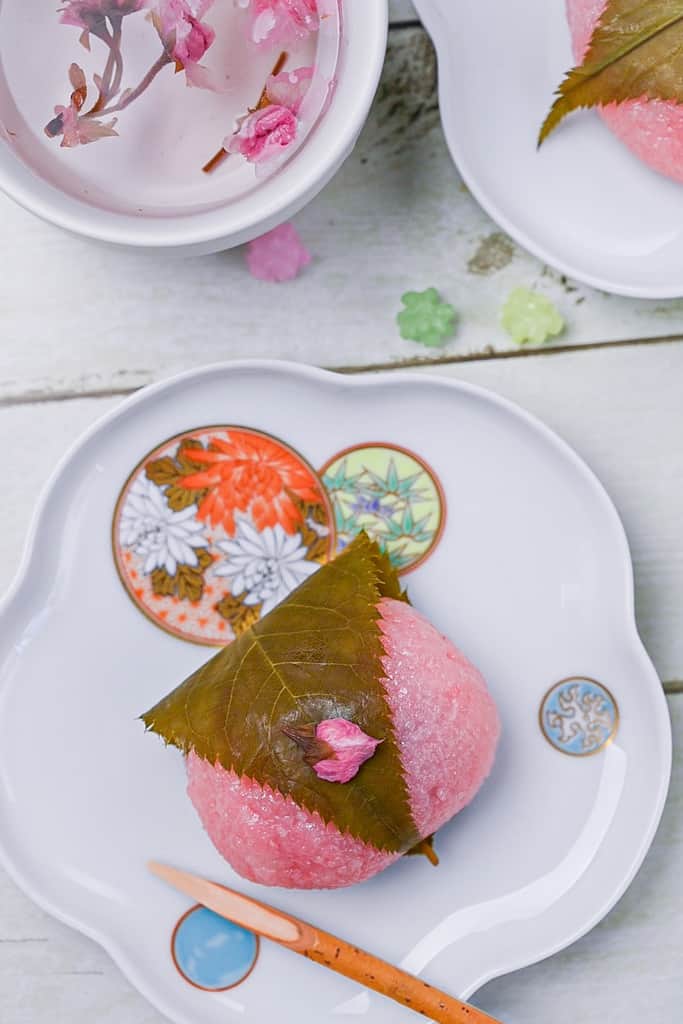
How to Make Salted Cherry Blossom Leaves
Sakura Mochi would not be complete without its iconic leaf that not only acts as decoration, but also adds a fragrant and mildly salty flavor to the rice.
“Sakura no Ha no Shiozuke” (桜の葉の塩漬け) are made by blanching and soaking the leaves of a “double cherry blossom tree” in a salt brine. Before using them, they should be soaked in fresh water for 1 hour to remove the excess salt and then gently dried with kitchen paper.
It can be difficult to find salt-pickled sakura leaves outside of Japan, but luckily it’s not too difficult to make them at home if you have access to the right type of cherry blossom tree.
- Pick fresh leaves from a cherry blossom tree (don’t use fallen leaves), then wash them with warm water and trim the stems.
- Fill one bowl with ice-cold water and one with boiling water.
- Drop the leaves into the boiling water for a few seconds and then immediately transfer them into the ice water. The boiled water will kill bacteria and remove any leftover dirt or pesticides, then the ice water stops the leaves from “cooking” and becoming wilted.
- In a jug, mix 40g of salt with 100ml warm water and mix until completely dissolved.
- Stack the leaves and place them in a ziplock bag.
- Pour the salt brine over the leaves, press them flat, and push the air out of the bag. Seal the bag and place it in the fridge under a weight for 1-2 days.
- Use within one year. Soak in fresh clean water for 1 hour before using.
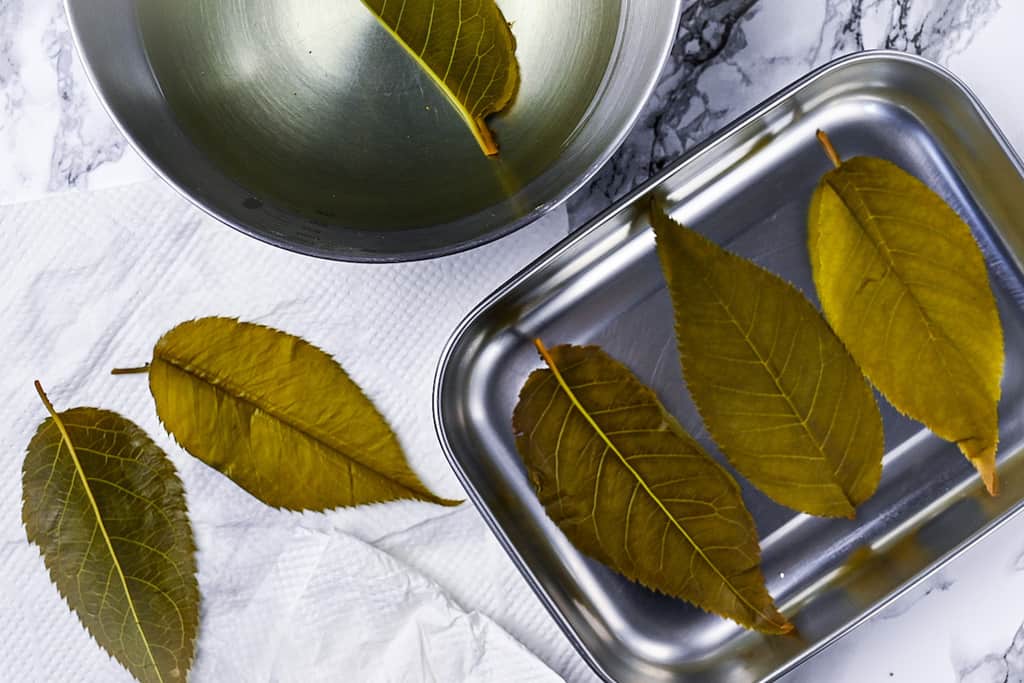
Visual Walkthrough & Tips
Here are my step-by-step instructions for how to make Sakura Mochi from scratch. For ingredient quantities and simplified instructions, scroll down for the Printable Recipe Card below.
If you prefer to watch the process in action, check out my YouTube video of this Sakura Mochi recipe for a complete visual walkthrough!
Place the mochi rice in a fine mesh sieve over a mixing bowl and fill it with fresh water. Gently swish, drain and repeat 3 times in total to wash the rice.
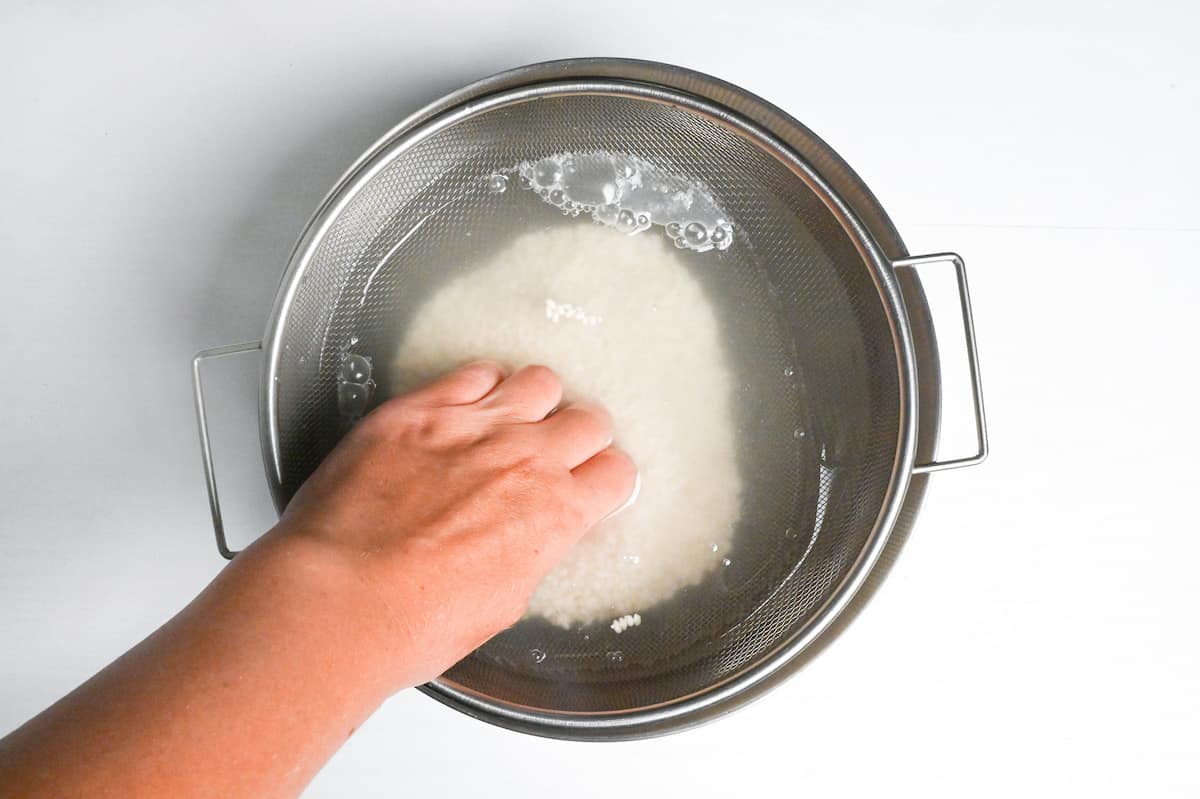
Fill the bowl once more and leave it to soak for 1 hour.
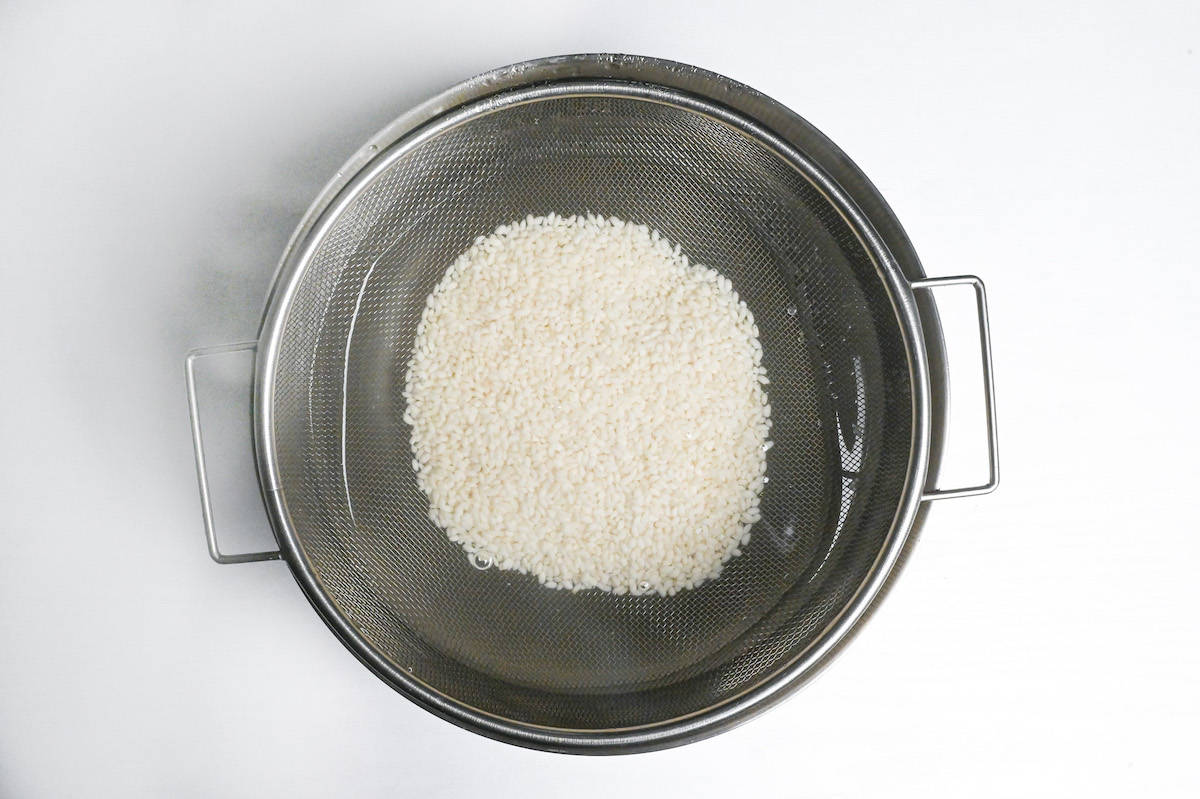
After 1 hour, dump the water and let the rice air dry for 10 minutes.
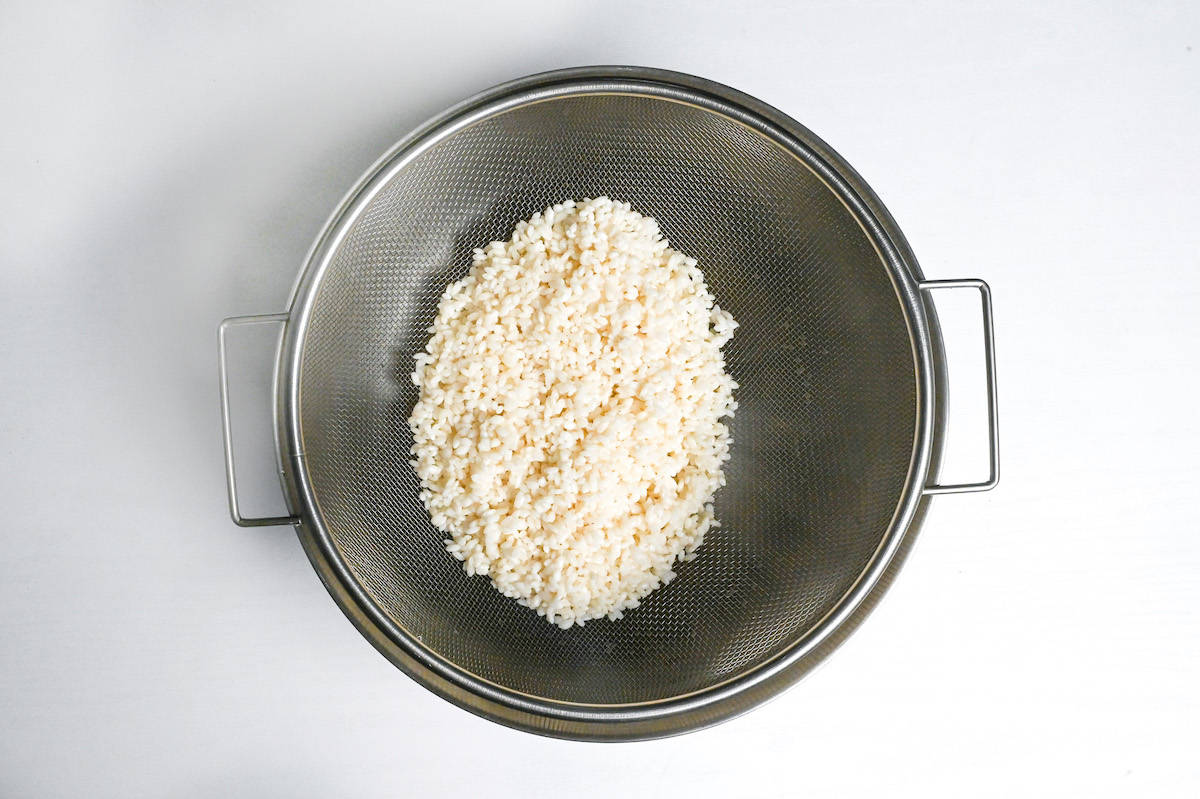
Transfer the rice to a cheese cloth and pound it with a rolling pin to crush it. Below is a before and after picture.
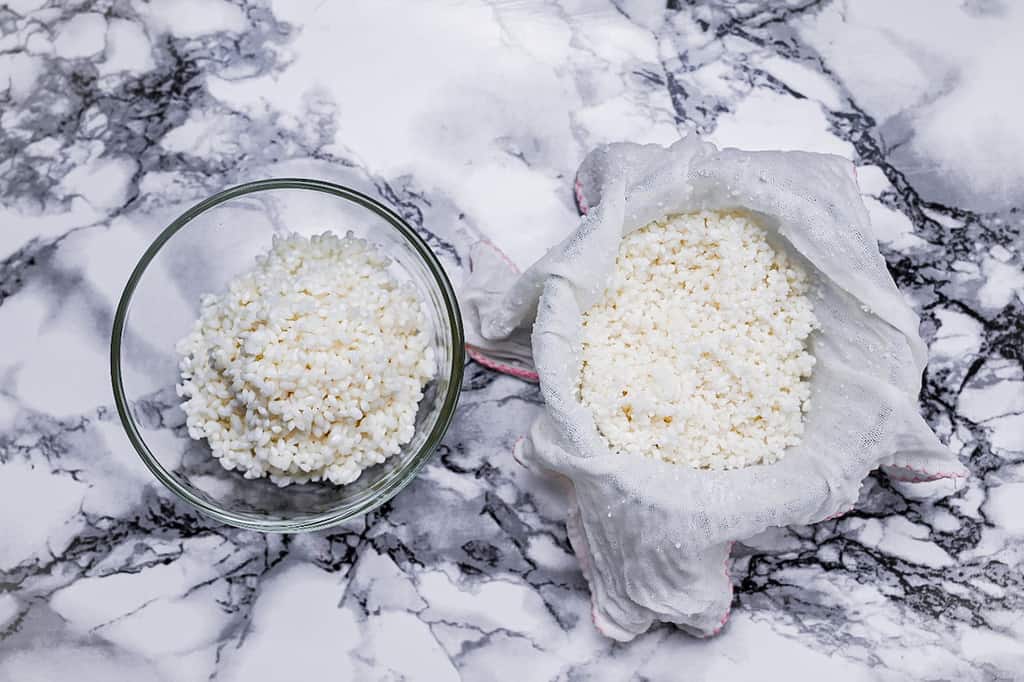
Microwave Method: transfer the rice to a microwavable bowl, with water, sugar and a drop of red/pink food coloring (see recipe below for quantities). Cover with plastic wrap and microwave at 600W in 2 minute intervals 3 times, stirring each (6 minutes in total). Stir one more time and then cover and leave to rest in the steam for 10 minutes.
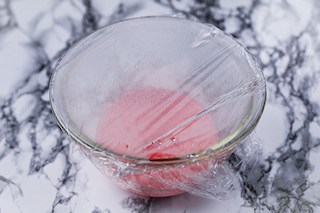
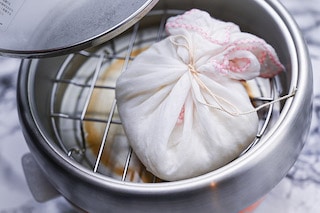
Steaming Method: Place the rice wrapped in the cheese cloth into a steamer for 30-40 minutes or until cooked all the way through. Make sure the rice isn’t touching the water.
Once cooked, transfer to a bowl and mix with sugar and a drop of pink or red food coloring.
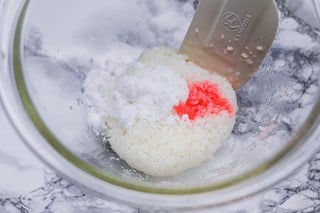
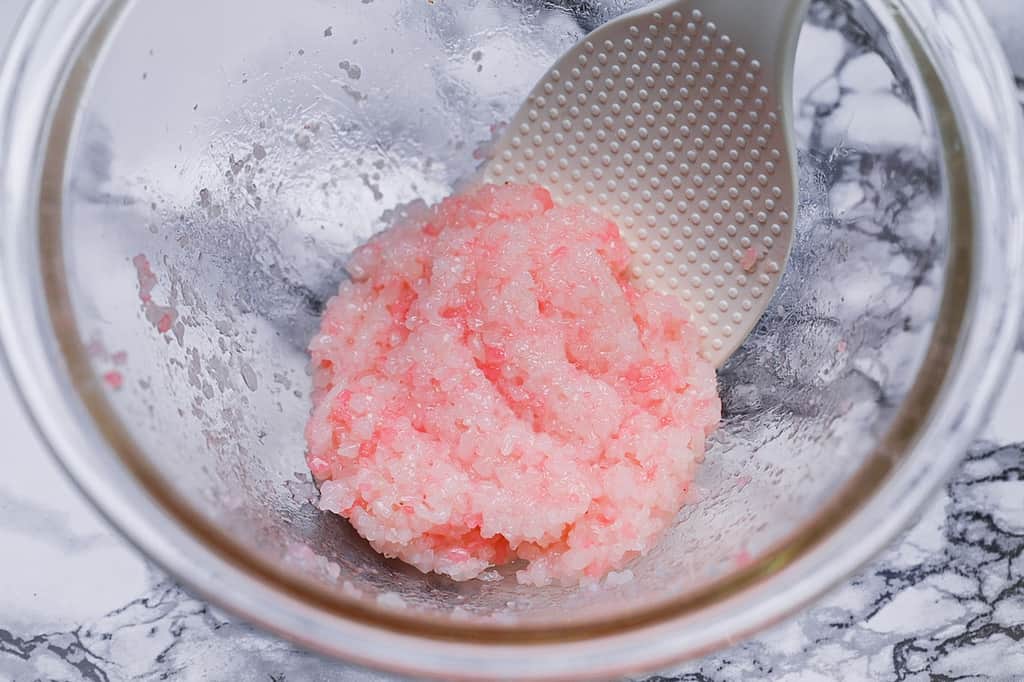
While the rice is cooking, place the pickled sakura leaves in a bowl of water for about 1 hour. After one hour, dry them by gently patting them with kitchen paper. I recommend doing this right before assembling.
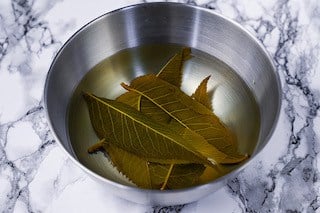
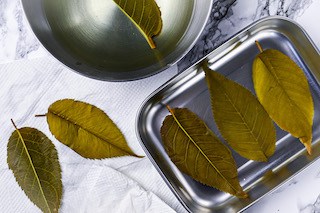
Roll the anko into balls and store in the fridge until it’s time to assemble. Each ball should be about 20g or ¾ oz.
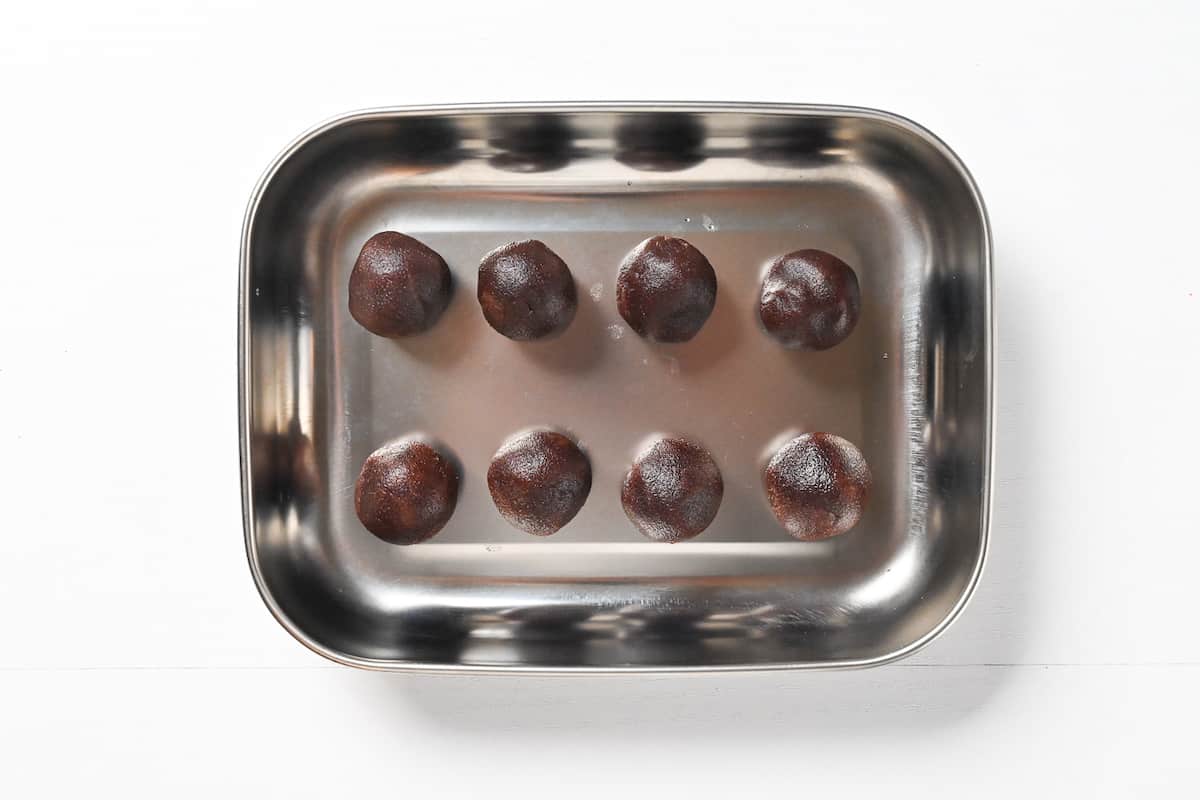
Once the rice is cooked and cool enough to touch, divide it into equal portions. I recommend keeping a bowl of water nearby and wetting your hands and cooking utensils to prevent sticking.
Roll each portion into a ball and place it on a piece of baking paper.
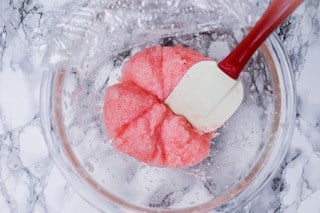
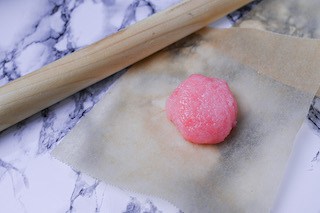
Place another piece of baking paper on top of the rice ball, roll it flat with your rolling pin and then peel off the paper and place a ball of anko in the middle.
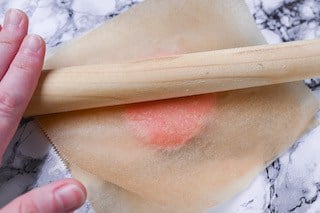
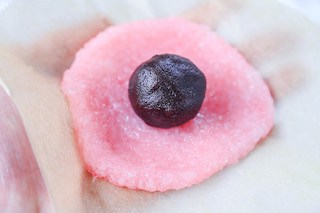
Wet the tips of your fingers and pinch the edges of the mochi together to seal the anko inside. You can also use the kitchen paper to help you wrap it.
Once sealed, turn it over so the seam is underneath and wrap with the soaked sakura leaves from earlier.
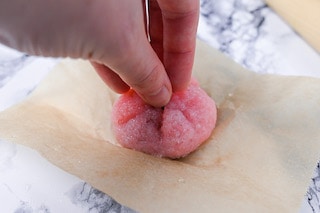
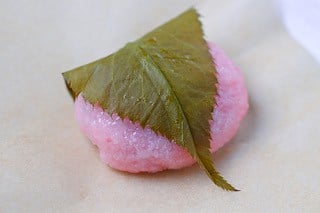
If decorating with salted sakura flowers, soak for 10-20 minutes before drying and placing them on top of the Sakura Mochi.
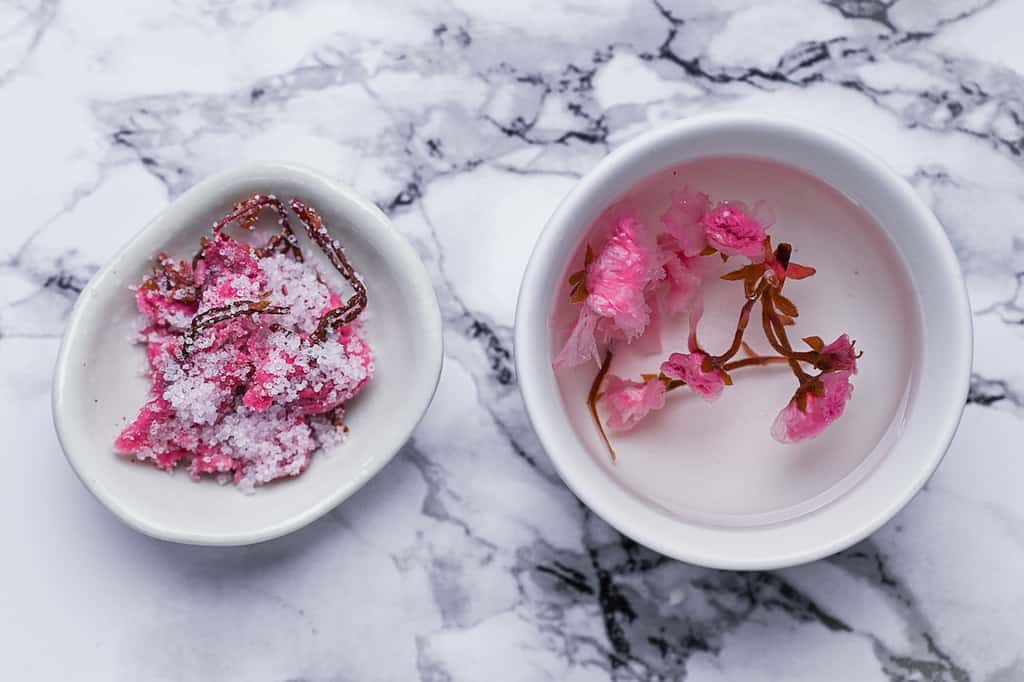
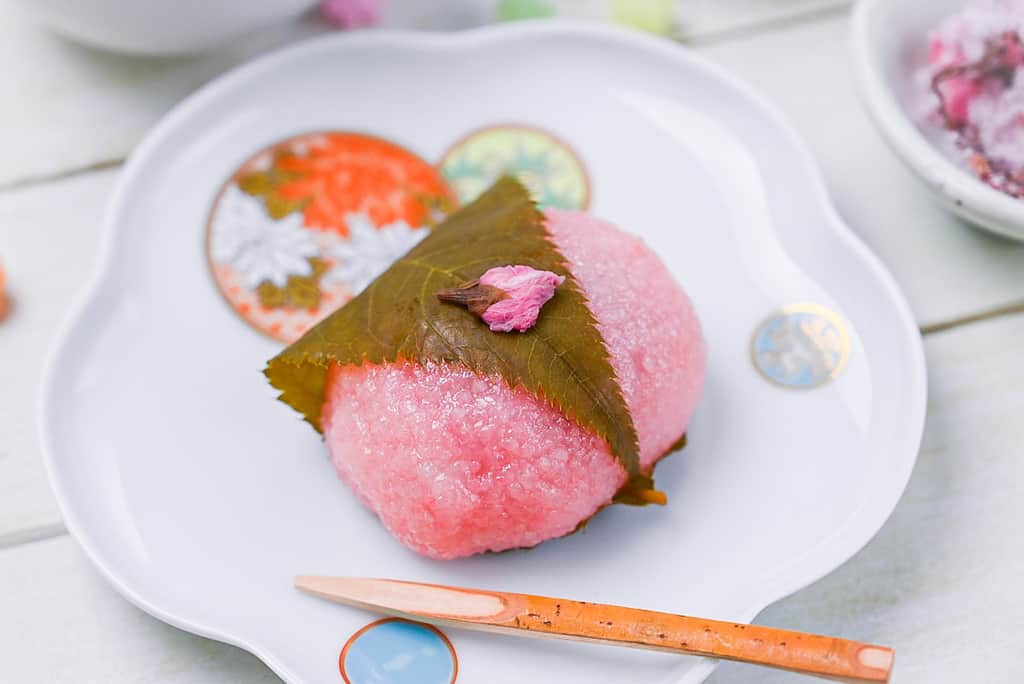
Enjoy!
Jump to Full Recipe MeasurementsTips & Tricks
Making Sakura Mochi at home isn’t difficult, but it can be quite sticky and hard to handle. Here are a few tips and tricks to make things a bit easier!
- Shape and Chill the Anko: Anko can become quite sticky when it’s warm, so i recommend keeping it in the fridge. If you shape it in advance and chill in the fridge or freezer before assembling, it will keep its shape and be easier to wrap with the mochi rice.
- Use Baking Paper to Shape: Although wetting your hands should be enough to stop the mochi rice from sticking, I like to roll it out using two sheets of greaseproof baking paper (one on top, one underneath). This creates a smoother finish and helps prevent getting too much water on the rice. Clean up is easy too! Alternatively you can use plastic wrap sprinkled with a little water.
- Wet Your Hands & Tools: To stop the mochi from sticking to everything, wet your spatula/spoons and hands with cold water when handling or mixing. This technique is also used for making sushi or onigiri too, water stops rice from sticking to things.
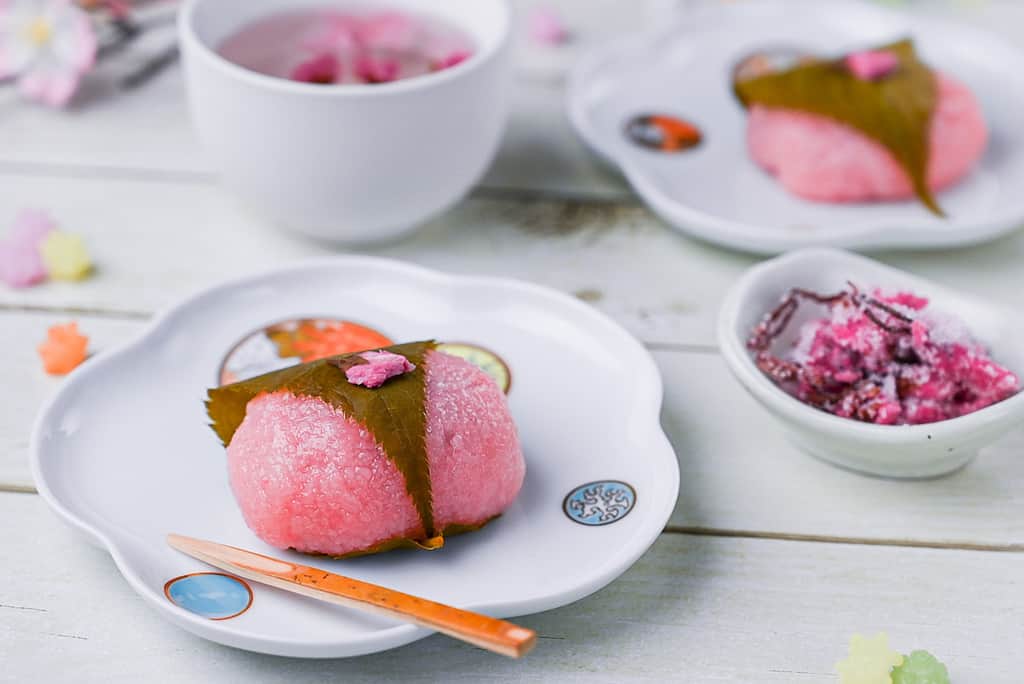
How to Store
Sakura mochi is best eaten the same day as the rice tends to go hard when exposed to the air. If you want to eat it the next day then wrap them individually in plastic wrap and keep them in the fridge in an airtight container or zip lock bag to stop them from drying out.
Storage Summary
Room temperature – A few hours.
Refrigerated – Not recommended. Maximum 12 hours (wrapped and stored in an airtight container).
Frozen – Not recommended.

FAQ
Sakura mochi is made with mildly sweet rice wrapped around earthy and sweet red bean paste. The surface absorbs some of the salt and herby flavor from the pickled cherry blossom leaf, giving it a unique and slightly fragrant taste.
Salted cherry blossom leaves are edible and are a huge contributor to the iconic flavor of Sakura Mochi. Of course, whether you eat it or not is down to personal preference, but most Japanese people eat it (including me).
Unfortunately, it can be very difficult to find domyojiko, even in Japan! Generally, it’s only sold in spring as doesn’t have much use other than to make Sakura Mochi.
When I need domyojiko, I buy it at the Japanese cooking store called “Tomizawa Shoten” and order it online here. They also sell a “Sakura Mochi Kit” that includes everything you need to make sakura mochi at home! If you visit Japan or know someone who will, you can direct them here.
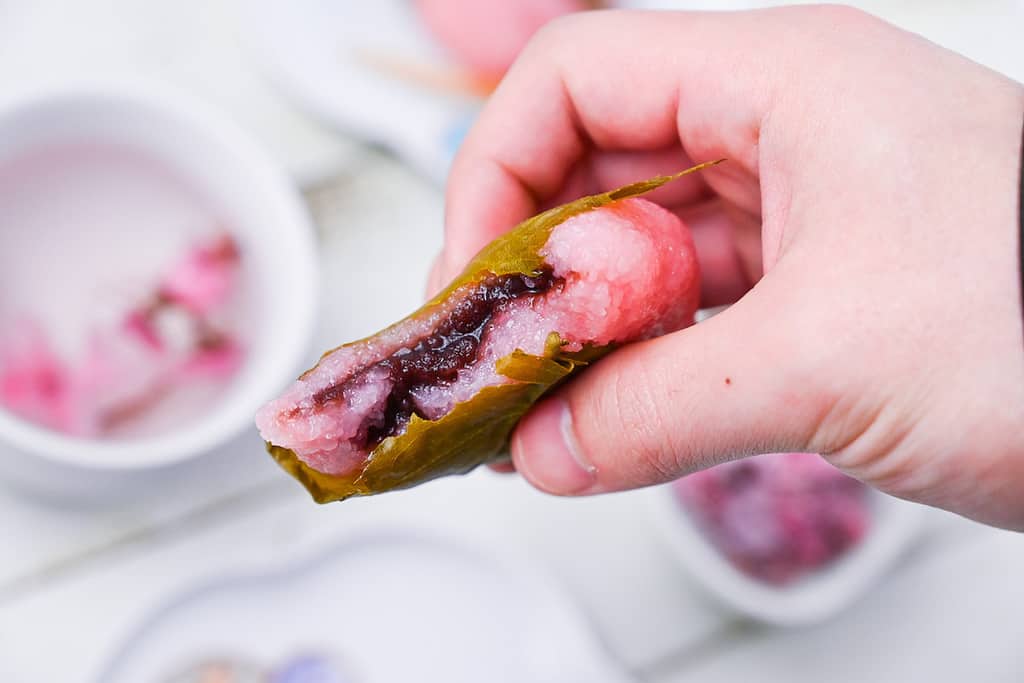
I hope you enjoy this Sakura Mochi recipe! If you try it out, I’d really appreciate it if you could spare a moment to let me know what you thought by giving a review and star rating in the comments below. It’s also helpful to share any adjustments you made to the recipe with our other readers. Thank you!
More Wagashi Recipes
- Ichigo Daifuku (Strawberry Mochi)
- Mitarashi Dango (Rice Dumplings with Homemade Sauce)
- Warabi Mochi (Bracken Cakes with Homemade Kuromitsu Syrup)
- Kashiwa Mochi (Children’s Day Rice Cakes)
Want more inspiration? Explore my Japanese Dessert Roundup Post for a carefully selected collection of tasty recipe ideas to spark your next tea party!
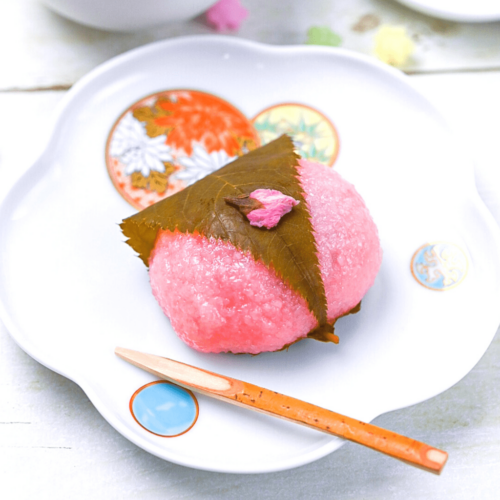
Sakura Mochi (Kansai-Style Cherry Blossom Rice Cakes)
Ingredients
- 150 g glutinous rice (mochigome/sweet rice) OR domyojiko
- 6-8 salted cherry blossom leaves
- 175 ml water plus extra for washing/soaking
- 2 tbsp white sugar
- 1-2 drops of pink food coloring or half the amount of red food coloring
- 120-160 g smooth red bean paste (koshian)
- salted cherry blossom flowers optional to decorate
My recommended brands of ingredients and seasonings can be found in my Japanese pantry guide.
Can’t find certain Japanese ingredients? See my substitution guide here.
Instructions
- Place 150 g glutinous rice in a sieve over a bowl. Fill the bowl with water, gently swish the rice around and then drain, repeat 3 times to wash. Fill the bowl one more time and leave the rice to soak for 1 hour.

- Soak 6-8 salted cherry blossom leaves in a bowl of cold water for 1 hour while the rice is soaking.

- Roll 120-160 g smooth red bean paste (koshian) into equally sized balls, one for each sakura mochi (approx 20g / ¾ oz each). Store in the fridge until it's time to assemble.

- After an hour, drain the water and let the rice dry for 5-10 minutes. If using a steamer, start heating your water.

- Transfer the rice to a damp cheese cloth and loosely wrap it before lightly pounding it with a rolling pin to break it up. Aim for a texture similar to a very coarse sugar like turbinado.

Microwave Method
- Transfer the broken rice to a microwavable bowl and add 175 ml water, 2 tbsp white sugar and 1-2 drops of pink food coloring. Whisk. (If using domyojiko, leave to soak for 10 minutes.)

- Cover the bowl with plastic wrap and microwave at 600W for 2 minutes. Mix thoroughly with a rice paddle or silicone spatula and repeat three times, 6 minutes in total. (If the rice seems hard or watery, microwave for an additional 20-30 seconds at a time until the rice is soft and the water is gone.)

- Mix once more and cover with a damp tea towel. Rest for 10-15 minutes or until cool enough to touch.

Steam Method
- Wrap the broken rice in the cheesecloth and tie it with butcher's string. Transfer it to the steaming basket, place the lid on and steam over a medium heat for 30-40 minutes or until soft. (Test the softness by squashing a grain between your thumb and forefinger.)

- Transfer the cooked rice to a bowl and add 2 tbsp white sugar and 1-2 drops of pink food coloring.

- Mix thoroughly with a rice paddle or silicone spatula until evenly colored and sweetened.

- Cover with a damp tea towel and allow to cool for 10-15 minutes or until cool enough to touch.
How to Shape
- Gently dry the sakura leaves by patting them with kitchen paper.

- If using, soak salted cherry blossom flowers in a small bowl of water for 10 minutes.

- Once the mochi rice is cool enough to touch, wet a rice paddle and divide it into equal portions. (This recipe makes 6 or 8 depending on how thick you want the rice to be.)

- Wet your hands with cold water and roll each portion into a ball.

- Press the ball of mochi flat in your palm. Alternatively, place the ball of mochi between two squares of parchment paper and flatten with a rolling pin.

- Place a ball of anko in the centre.

- Wet your fingers and then pinch the edges of the rice up around the ball of anko to close it up, turning the mochi as you go to help prevent sticking.

- Wet your hands and roll the sakura mochi in your palm to finish shaping it into a ball or oval. Wrap with a salted sakura leaf and decorate with a salted sakura flower.

- Enjoy!
Video
Notes
- Make sure the rice has cooled before handling.
- If the mochi dough is unmanageably sticky, let it air dry for 5-10 minutes, then mix and try again.
- Keep a bowl of water nearby so you can wet your hands regularly to prevent the rice from sticking.
- If you prefer a thinner rice layer, you can divide the rice into 8 instead of 6.
- If increasing the recipe, you will need to microwave it for longer. Heat in 30-second increments and mix well, repeat until the rice is cooked through and the water is gone.
- Best eaten the same day.
- Eating the leaf is optional.
- To store, wrap in plastic wrap and place in an airtight container. Place in the refrigerator and consume within 24 hours.
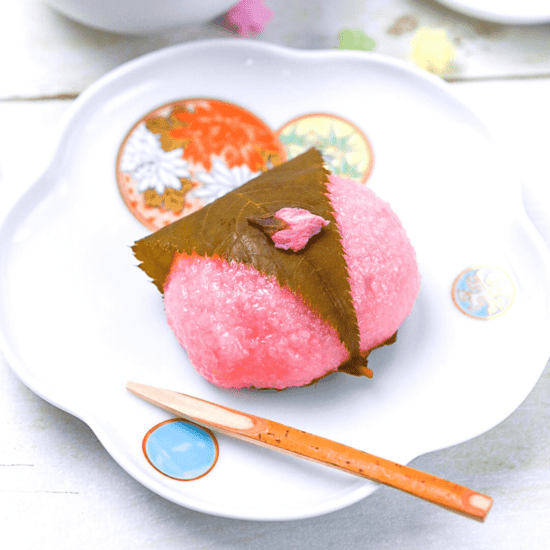




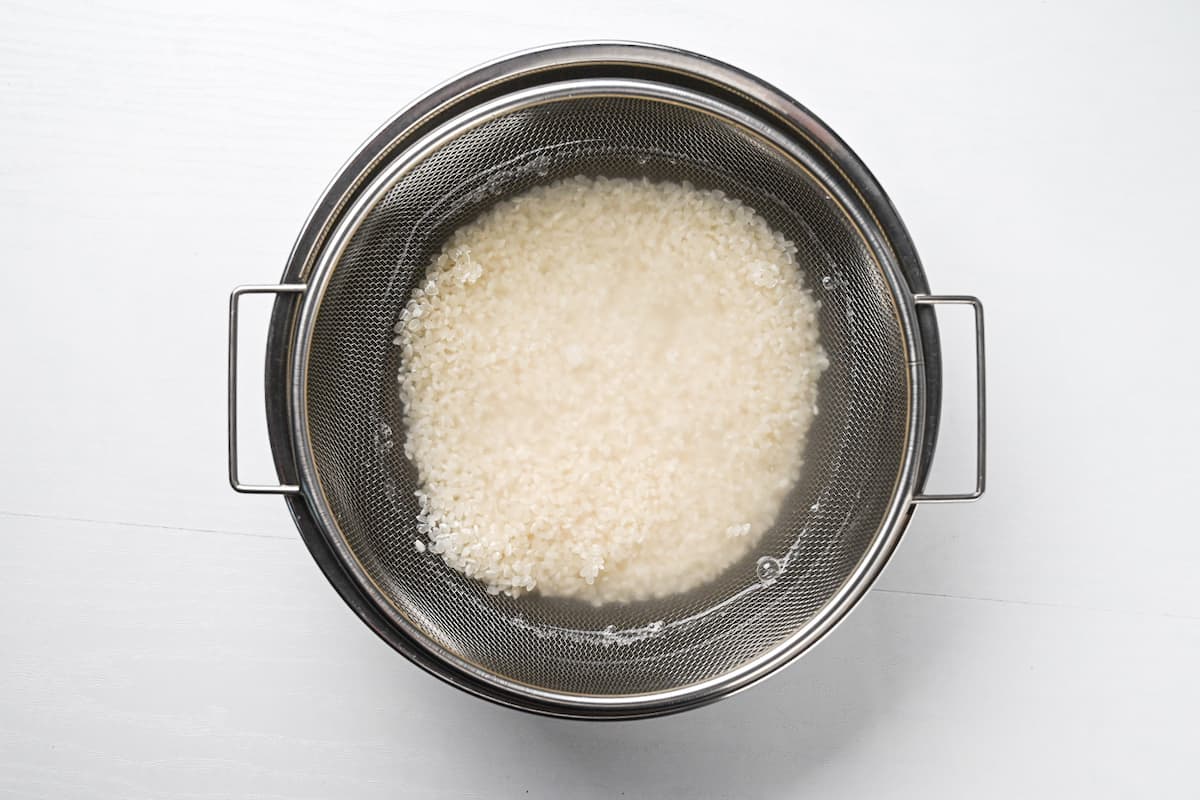
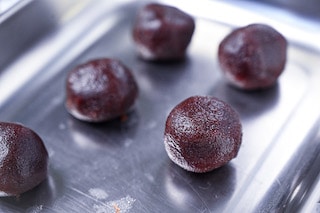

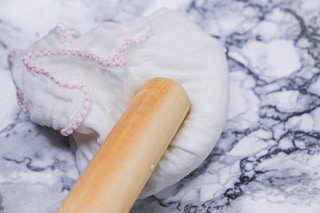
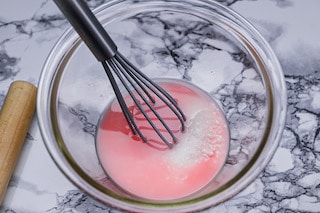
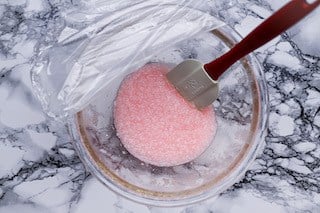
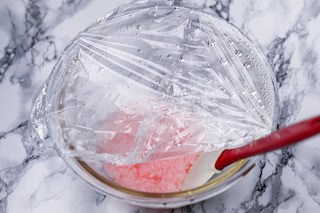
Leave a rating and a comment